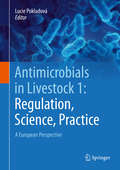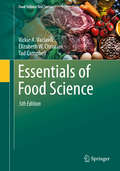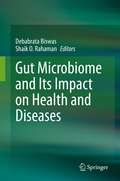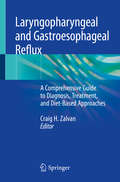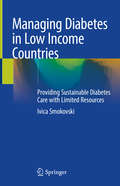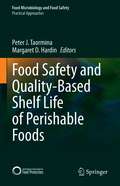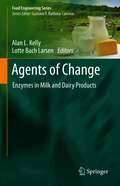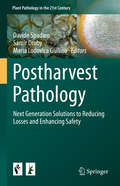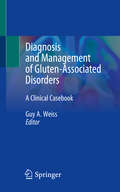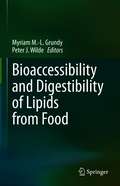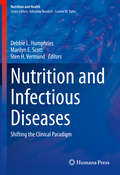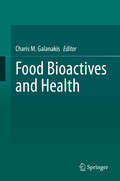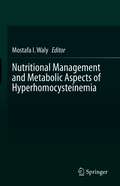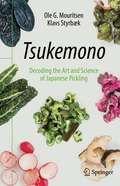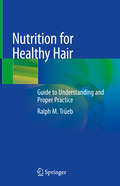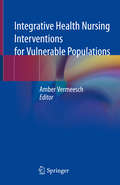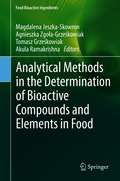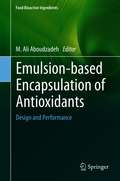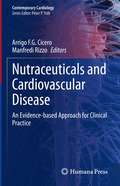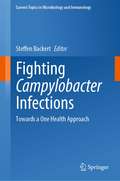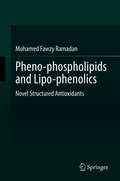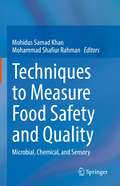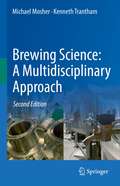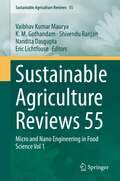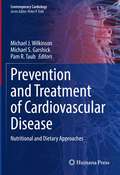- Table View
- List View
Antimicrobials in Livestock 1: A European Perspective
by Lucie PokludováThis first volume in a two-volume work enhances readers’ understanding of antimicrobial resistance mechanisms in selected bacterial species that cause diseases in major food producing animals. It provides an overview of the current legislation and policies seeking to regulate the authorisation, manufacturing, distribution and use of veterinary antimicrobials in practice in a way that helps to contain the spread of antimicrobial resistance. The focus is put on Europe, without neglecting the global context. Moreover, attention is paid to various uses of antimicrobials in livestock, considering both their risks and benefits, from the distant past to the present. Growth promotion, prophylaxis, metaphylaxis, diagnostics and treatment are discussed not only with regard to food production and animal health, but also considering the One Health concept, which combines public and animal health with environmental aspects. A summary of various systems for monitoring the use of antimicrobials is provided, as well as an overview of the diseases that European veterinarians most often treat with antimicrobials. In closing, the book addresses the complexity of recent measures that are of key importance for antimicrobial stewardship, e.g. biosecurity, vaccination and other preventive tools including the newest technologies like smart farming. The complete two-volume work provides an extensive review of various aspects related to the use of antimicrobials in veterinary medicine, especially considering major food producing species, their most common infectious diseases and causative pathogens, and mainly focusing on the situation in Europe, without ignoring the global context. While Volume I discusses more general aspects of antibiotic use such as regulatory, laboratory and practical issues from different perspectives, Volume II more specifically discusses medical aspects and the use of antimicrobials in cattle, pigs, poultry and horses, as well as pharmacokinetics and pharmacodynamics, two of the most important factors determining the success of treatment. In both volumes, each chapter confronts the reader with open questions to stimulate further discussions and future research on the topics covered.
Essentials of Food Science (Food Science Text Series)
by Vickie A. Vaclavik Elizabeth W. Christian Tad CampbellThe fifth edition of the Essential of Food Science text continues its approach of presenting the essential information of food chemistry, food technology, and food preparations while providing a single source of information for the non-major food science student. This latest edition includes new discussions of food quality and new presentations of information around biotechnology and genetically modified foods. Also new in this edition is a discussion of the Food Safety Modernization Act (FSMA), a comparison chart for Halal and Kosher foods and introductions to newly popular products like pea starchand the various plant-based meat analogues that are now available commercially and for household use. Each chapter ends with a glossary of terms, references, and a bibliography. The popular “Culinary Alert!” features are scattered throughout the text and provide suggestions for the reader to easily apply the information in the text to his or her cooking application. Appendices at the end of the book include a variety of current topics such as Processed Foods, Biotechnology, Genetically Modified Foods, Functional Foods, Nutraceuticals, Phytochemicals, Medical Foods, and a Brief History of Foods Guides including USDA Choosemyplate.gov. V.A. Vaclavik, Ph.D., RD. has taught classes in nutrition, food science and management and culinary arts for over 25 years at the college level in Dallas, Texas. She is a graduate of Cornell University, human nutrition and food; Purdue University, restaurant, hotel, institution management; and Texas Woman’s University, institution management and food science. Elizabeth Christian, Ph.D. has been an adjunct faculty member at Texas Woman’s University for more than 25 years, teaching both face-to-face and online classes in the Nutrition and Food Science department. She obtained her B.S. and her PhD. In Food Science from Leeds University, England, and then worked as a research scientist at the Hannah Dairy Research Institute in Scotland for Five years before moving to the United States. Tad Campbell, MCN, RDN, LD is a clinical instructor at The University of Texas Southwestern Medical Center at Dallas, where he teaches Food Science and Technology as well as other nutrition courses in the Master of Clinical Nutrition – Coordinated Program. He holds a Bachelor of Business Administration degree from Baylor University as well as a Master of Clinical Nutrition from UT Southwestern where he studied Food Science under Dr. Vickie Vaclavik.
Gut Microbiome and Its Impact on Health and Diseases
by Debabrata Biswas Shaik O. RahamanThis book provides a comprehensive examination of the role of gut microbiome/microflora in nutrition, metabolism, disease prevention and health issues, including farm animal health and food value, and human gastrointestinal health and immunity. Indigenous microbiotas, particularly the gut microflora/microbiome, are an essential component in the modern concept of human and animal health. The diet and lifestyle of the host and environment have direct impact on gut microflora and the patterns of gut microbial colonization associated with health and diseases have been documented.Contributing authors cover the impact of gut microbiome in farm animal health, and explore the possibility of modulating the human gut microbiome with better animal products to prevent human diseases, including endemic and emerging diseases such as obesity, cancer and cardiac diseases. Dieting plan and control methods are examined, with attention paid to balance dieting with natural food and drink components. In addition, the role of gut microbiota in enteric microbial colonization and infections in farm animals is also discussed.The volume also explores the possibility of improving human health by modulating the microbiome with better food, including bio-active foods and appropriate forms of intake. Throughout the chapters, authors examine cutting edge research and technology, as well as future directions for better practices regarding emerging issues, such as the safety and production of organic food.
Laryngopharyngeal and Gastroesophageal Reflux: A Comprehensive Guide to Diagnosis, Treatment, and Diet-Based Approaches
by Craig H. ZalvanThis text comprehensively reviews the current state of the art in Laryngopharyngeal Reflux (LPR) together with a comprehensive explanation and description of the known gastroesophageal reflux (GERD) literature. With chapters written by experts from around the world, this text aims to deliver what is current in reflux recognition, diagnosis, reflux related complications, and the various treatment modalities. This is the first textbook to combine the most up to date knowledge of both LPR and GERD meant for both specialties and the general medicine population. Completely unique to the reflux literature is a section detailing the substantial benefits of a mostly plant based, Mediterranean style diet in the treatment of reflux disease. Encouraging patients to read and learn about diet and health is likely the most important step in improving their disease. The text provides direction to the caregiver on how to transition to a mostly plant-based diet. Review of myths, effects of diet in the setting of other disease states, and dietary consequences are explained. Guidelines on how to transition diet, dining out while maintaining a plant-based diet, and how to wean off medication, such as PPI, are also provided.Laryngopharyngeal and Gastroesophageal Reflux: A Comprehensive Guide to Diagnosis Treatment, and Diet-Based Approaches will provide the medical community with a resource to understand, teach, and provide the latest in LPR and GERD information to the caregiver and subsequently the patient.
Managing Diabetes in Low Income Countries: Providing Sustainable Diabetes Care with Limited Resources
by Ivica SmokovskiThis book covers the complexity of diabetes and related complications and presents the socio-economic burden of the disease, taking into account the rising prevalence reaching pandemic proportions and the associated costs. Factors causing high diabetes prevalence and the influence of the pharmaceutical industry are evaluated and solutions for sustainable diabetes care with limited resources are provided, including national focus on providing cost-effective diabetes treatment, nutrition and physical activity, structured diabetes education and centralized National e-Health System. Moreover, elaboration of long-term efforts to curb the diabetes burden through prevention activities are presented in this book.Managing Diabetes in Low Income Countries represents an essential guide for diabetes care clinicians and researchers, medical students and clinicians in training, diabetes policy makers, regulatory authorities, international diabetes and patient organisations all of whom are involved in current clinical practice for diabetes management.
Food Safety and Quality-Based Shelf Life of Perishable Foods (Food Microbiology and Food Safety)
by Peter J. Taormina Margaret D. HardinThis book addresses the shelf life of foods, a key factor in determining how food is distributed and consequently where and when different food products are available for consumption. Shelf life is determined by several factors, including microbiological, chemical, physical, and organoleptic deterioration. Often these factors are interrelated and interdependent. The editors of this volume focus specifically on the microbial factors related to shelf life of perishable foods and food commodities. This allows for more detailed coverage of foodborne bacterial pathogens and spoilage microorganisms of concern. The initial part of the book covers the why and how of shelf life determination as well as the specific microbial pathogens and spoilage microorganisms of concern for perishable foods. Contributors address topics such as the techniques utilized for determination of shelf life, the frequency of shelf life testing for different products, the interpretation of data to make shelf life determinations, and management of shelf life of food products from the perspective of the food producer, distributor, retailer, and regulator. Three key areas impacting shelf life are addressed in detail: sanitation, processing, and packaging. The sanitation chapter explains the necessary components of cleaning and sanitizing to assure a hygienic processing environment and why that is critical to shelf life control. Traditional processing procedures are reviewed and advanced processing technologies are explored. Materials used in food packaging and the utilization of traditional and activated food packaging by product type are covered in detail. The latter two chapters of the book delve into newer techniques of analysis and explore the microbiome of food products. Implications of microbial ecology and microbial quantification in food products are discussed in chapters on genomics and in the changing dogma of meat shelf life. The primary audience for this work includes food industry quality and food safety technicians, managers, directors, and executives responsible for shelf life. Academicians and governmental researchers involved in research and teaching about food safety and quality will also find the material relevant and useful.
Agents of Change: Enzymes in Milk and Dairy Products (Food Engineering Series)
by Alan L. Kelly Lotte Bach LarsenThe enzymology of milk and other products is of enormous significance for the production and quality of almost every dairy product. Milk itself is a complex biological fluid that contains a wide range of enzymes with diverse activities, some of which have identifiable functions while others are present as an accidental consequence of the mechanism of milk secretion. Over time milk enzymology has become an incredibly essential component of milk and other dairy product production, and with advancing technology and processing techniques, its importance is at its peak. Dairy Enzymology presents an expansive overview of the enzymology of milk and other dairy products, focusing on the use of indigenous and endogenous enzymes in milk and exogenous enzymes in cheese processing. A full section is dedicated to the enzymology of bovine milk, focusing on the main families of indigenous enzymes as well as their potential significance in the mammary gland plus the technological significance for the properties of dairy products. Implications for the manufacture and ripening of cheese plus the use of enzymes such as alkaline phosphatase for measuring heat treatment in milk are explored in full, and the role of milk protease plasmin and other indigenous enzymes in the age-gelation is focused on. Further sections focus on enzymes found in raw milk and enzymes deliberately added for manufacture or modification of properties and the manufacture of food ingredients from dairy-derived ingredients. The key bacterial families are discussed in depth as well as their known contributions to the quality of dairy products. With its comprehensive scope and fully up-to-date coverage of dairy product enzymology, this text is a singular source for researchers looking to understand this essential dairy processing aspect.
Postharvest Pathology: Next Generation Solutions to Reducing Losses and Enhancing Safety (Plant Pathology in the 21st Century #11)
by Davide Spadaro Samir Droby Maria Lodovica GullinoThe book will address selected topics in postharvest pathology aiming at highlighting recent development in the science, technology and control strategies of postharvest diseases to reduce losses and enhance safety of harvested agricultural products. Topics will include: 1) Introduction: Perspectives and challenges in postharvest pathology 2) Elucidating host-pathogen interactions 3) Next generation technologies for management and detection of postharvest pathogens 4) Food safety in postharvest pathology 5) Alternative postharvest diseases control strategies 6) Chemical control of postharvest diseases
Diagnosis and Management of Gluten-Associated Disorders: A Clinical Casebook
by Guy A. WeissThis clinical casebook provides a comprehensive yet concise state-of-the-art review of gluten-associated disorders. Presented in a case-based format, the casebook reviews the overall management of celiac disease (from seronegative through classical to refractory disease) as well as non-celiac gluten/wheat sensitivity, with an emphasis on gastrointestinal and extra-intestinal manifestations of these disorders. Specific topics presented in these cases include, for instance, dermatitis herpetiformis, celiac disease and the liver, non-responsive celiac disease, celiac crisis, overlap with functional gastrointestinal disorders, and fructan intolerance. Two chapters written by expert dieticians share their experience in managing celiac disease and gluten/wheat sensitivity. Written by international experts in the field, Diagnosis and Management of Gluten-Associated Disorders: A Clinical Casebook is a valuable resource for both adult and pediatric gastroenterologists, hepatologists, primary care physicians, dermatologists, registered dieticians, trainees, and researchers interested in gluten-associated disorders.
Bioaccessibility and Digestibility of Lipids from Food
by Myriam M.-L. Grundy Peter J. WildeThe structure of a food influences the way it is transformed during processing and digestion. This in turn has an impact on nutrient bioaccessibility (release) and digestibility, and subsequently on the physiological response and health of the individual who consumes that food. Although evidence exists on the health benefits associated with the inclusion of certain lipid-rich foods (e.g. nuts, dairy products and fish) in the diet, the mechanisms that explain the physiological effects and the long-term benefits are not well understood. Lipids in themselves have many beneficial health effects: they are a source of energy and essential fatty acids, they are structural components of cell membranes, they are required to solubilise fat soluble compounds, and they serve as precursors of hormones. In addition, the overall structure of the food containing the lipids plays a crucial role in determining health benefits, notably by influencing lipid bioaccessibility and digestibility. Bioaccessibility and digestibility of lipids from food uniquely focuses on the physico-chemical properties of lipids and lipid rich food, as well as the subsequent effects on human health. Chapters from experts in food digestion examine food structure at both the macro- and micro- levels, covering lipids from plant and animal food products. The editors have developed the book for dietitians, nutritionists, and food scientists. Clinicians and other health professionals, educators in nutrition, and others working in the food industry will also find the material relevant.
Nutrition and Infectious Diseases: Shifting the Clinical Paradigm (Nutrition and Health)
by Debbie L. Humphries Marilyn E. Scott Sten H. VermundThis comprehensive and user-friendly volume focuses on the intersection between the fields of nutrition and infectious disease. It highlights the importance of nutritional status in infectious disease outcomes, and the need to recognize the role that nutrition plays in altering the risk of exposure and susceptibility to infection, the severity of the disease, and the effectiveness of treatment. Split into four parts, section one begins with a conceptual model linking nutritional status and infectious diseases, followed by primers on nutrition and immune function, that can serve as resources for students, researchers and practitioners. Section two provides accessible overviews of major categories of pathogens and is intended to be used as antecedents of pathogen-focused subsequent chapters, as well as to serve as discrete educational resources for students, researchers, and practitioners. The third section includes five in-depth case studies on specific infectious diseases where nutrition-infection interactions have been extensively explored: diarrheal and enteric disease, HIV and tuberculosis, arboviruses, malaria, and soil-transmitted helminths. The final section addresses cross-cutting topics such as drug-nutrient interactions, co-infections, and nutrition, infection, and climate change and then concludes by consolidating relevant clinical and public health approaches to addressing infection in the context of nutrition, and thus providing a sharp focus on the clinical relevance of the intersection between nutrition and infectionWritten by experts in the field, Nutrition and Infectious Diseases will be a go to resource and guide for immunologists, clinical pathologists, sociologists, epidemiologists, nutritionists, and all health care professionals managing and treating patients with infectious diseases.
Food Bioactives and Health (Food Bioactive Ingredients Ser.)
by Charis M. GalanakisBioactive natural compounds have gained attention in recent years due to their potential health benefits, including reducing the risk of diabetes, cancer, and cardiovascular diseases. These benefits derive from bioactive compounds' anti-tumor, anti-inflammatory, anti-oxidative, anti-hypertensive and anti-hyperlipidemic activities, which serve in addition to their basic nutritional functions. Over the last decade, researchers have investigated the health impact of bioactive compounds in detail, and the development of food applications has attracted great interest. Consumer demand has surged for functional foods (nutraceuticals), superfoods, and tailor-made foods, generated by supplementing traditional food products with bioactive ingredients. Food Bioactives and Health offers comprehensive coverage of the properties and health effects of food bioactives in view of new trends in processing, food science and food technology. Starting with the metabolic characteristics of polyphenols, glucosinolates, and other food bioactives, the text then dives into their impact on human health and recent applications in the world of food technology. For food scientists, food technologists, and product developers looking to understand the role of food bioactives in health and develop applications in personalized nutrition, functional foods and nutraceuticals, Food Bioactives and Health serves as a one-stop reference.
Nutritional Management and Metabolic Aspects of Hyperhomocysteinemia
by Mostafa I. WalyElevated blood concentrations of homocysteine, B vitamins deficiencies and oxidative stress are etiological factors for many human chronic diseases, yet the etiologic relationship of hyperhomocysteinemia to these disorders remains poorly understood. Clinical trials continue to support the notion that hyperhomocysteinemia is involved in the pathogenesis of oxidative stress and its associated impairment of cellular redox status. Antioxidants, phytochemicals, and bioactive agents are thought to be associated with the reduction of oxidative stress and reducing risk of chronic diseases, yet their role in preventing hyperhomocysteinemia-mediated oxidative stress has not been well covered in the literature. Nutritional Management and Metabolic Aspects and of Hyperhomocysteinemia comprehensively covers the nutritional-based intervention for combating hyperhomocysteinemia-mediated oxidative stress, metabolic regulation of homocysteine-dependent transulfuration and transmethylation pathways, and the identification of novel biomarkers for early diagnosis of hyperhomocysteinemia. The main goal of this text is to address the biochemical and nutritional aspects of hyperhomocysteinemia in relation to increasing risk of chronic diseases, providing insight into the etiology of hyperhomocysteinemia and covering new research on the effective reduction and management of hyperhomocysteinemia-associated chronic diseases. For researchers seeking a singular source for the understanding of the biochemical aspects and nutrition-based combat of hyperhomocysteinemia, its risk factors, preventive measures, and possible treatments currently available, this text provides all of the important needed information in up-to-date and comprehensive form.
Tsukemono: Decoding the Art and Science of Japanese Pickling
by Ole G. Mouritsen Klavs StyrbækOne of the best-kept secrets of Japanese cuisine is a range of side dishes known as tsukemono (つけもの, 漬物). The word, pronounced ‘tskay-moh-noh,’ means ‘something that has been steeped or marinated’ (tsuke—steeped; mono—things). Although tsukemono are usually made from vegetables, some fruits, flowers, and a few rhizomes are also preserved this way; it is, therefore, more accurate to characterize them as ‘pickled foods.’ Their preparation makes use of one or more conservation techniques, involving ingredients such as salt, sugar, vinegar, alcohol, and herbs, in combination with methods including dehydration, marinating in salt and acidic liquids, fermentation, and curing. The process of making tsukemono amounts to more than just a simple way of preserving otherwise perishable fresh produce. Apart from its nutritional value, the dish stimulates the appetite, provides delicious taste sensations, and improves digestion, all while remaining an elegant study in simplicity and esthetic presentation. This book goes well beyond explaining the secrets of making crisp tsukemono. The authors discuss the cultural history and traditions associated with these pickled foods; provide recipes and outline techniques for preparing them at home with local ingredients; describe the healthful benefits and basic nutritional value to be found in the various types of pickles; and show how easy it is to serve them on a daily basis to stimulate the appetite or as condiments to accompany vegetable, fish, and meat dishes. The goal is to encourage the readers of this book to join us in a small culinary adventure that will allow us to expand and diversify our consumption of plant-based foods, which are so vital to our overall well-being. And along the way, there may be a few surprises.
Nutrition for Healthy Hair: Guide to Understanding and Proper Practice
by Ralph M. TrüebThe quantity and quality of the hair are closely related to the nutritional state of an individual. And yet, there is hardly another field with so much prejudice, misconception, and debate as diet and health, let alone hair health. Pharmacy aisles and Internet drugstores are full of nutritional supplements promising full, thick, luscious hair for prices that range from suspiciously cheap to dishearteningly exorbitant. Since there lies an important commercial interest in the nutritional value of various nutritional supplements, a central question that arises is whether increasing the content of an already adequate diet with nutrients may further promote hair growth and quality. This book aims at distinguishing facts from fiction, and at providing a sound scientific basis for nutrition-based strategies for healthy hair, at the same time acknowledging the problems and limitations of our current understanding and practice.
Integrative Health Nursing Interventions for Vulnerable Populations
by Amber VermeeschThis book provides nurses, clinicians, practitioners, educators and students working with vulnerable and underserved populations with essential information on effective wellness strategies to address inadequate nutrition, promote physical activity, and reduce perceived stress through an integrative health nursing framework.It begins with an overview of cultural humility, health inequities, and social justice, establishing the need for an integrative health nursing framework. In turn, the book addresses a broad range of interventions; particular attention is given to wellness strategies designed to prevent the adverse effects of poor nutrition, perceived stress, and lack of physical activity. Written by respected experts in the field, the book offers readers valuable insights into strategies for working with vulnerable populations. Accordingly, it will appeal to researchers working to diminish health inequities among vulnerable populations, and will be of particular interest to nursing educators, practitioners, and students.
Analytical Methods in the Determination of Bioactive Compounds and Elements in Food (Food Bioactive Ingredients)
by Magdalena Jeszka-Skowron Agnieszka Zgoła-Grześkowiak Tomasz Grześkowiak Akula RamakrishnaMost bioactive compounds have antioxidant activity, particularly tocochromanols, phenolics (flavonoids and phenolic acids), methylxantines and capsaicinoids. Some of these compounds have also other properties important for human health. For example, vitamin E protects against oxidative stress, but it is also known for its “non-antioxidant” functions, including cell signalling and antiproliferation. Selenium compounds and indoleamins are the components of the antioxidant enzymes. Selenium makes vitamin E acquisition easier and controls its physiological functions. In taking part in enzymatic reactions and protecting the cell against free radicals, selenium shows immunomodulative, antiphlogistic, and antiviral activity. Capsaicinoids possess not only antioxidant, but also antibacterial, analgesic, weight-reducing and thermoregulation properties. Studies have also demonstrated their gastroprotective and anticancer properties. Analytical Methods in the Determination of Bioactive Compounds and Elements in Food explores both the influence of particular compounds on human health and the methods used for their determination. Chapters describe various aspects of food and plant analysis, including chromatographic and non‐chromatographic approaches as well as hyphenated techniques. Readers of this book will gain a comprehensive understanding of the important groups of bioactive compounds relevant to human health.
Emulsion‐based Encapsulation of Antioxidants: Design and Performance (Food Bioactive Ingredients)
by M. Ali AboudzadehThe limited aqueous solubility of bioactive pharmaceutical ingredients presents a tremendous challenge in the development of new drugs. In recent years, methods have been developed to protect these sensitive bioactive compounds, namely antioxidants, with the aim of increasing the public sanitation grades. Emulsion-based systems are particularly interesting as colloidal delivery encapsulation systems, because they can easily be created from food-grade ingredients using relatively simple processing protocols. It is one of the most favorable delivery systems to increase the solubility of phytochemicals, nutraceuticals and food additives.Emulsion‐based Encapsulation of Antioxidants: Design and Performance advances the field of colloid science through the investigation of the effects of formulation and process parameters that influence emulsion production. The book offers a deeper comprehension of the technological and biological aspects of the incorporation of encapsulated compounds in food matrices and explication of their activity. Chapters provide an overview of the status of emulsion-based formulations to encapsulate antioxidants, fabrication, properties, applications, and biological fate with emphasis on systems suitable for utilization within industry. Special emphasis is placed on the antioxidant activity of the carriers being the key advantage of these emulsion-based systems. The main aim of the book is to inspire and to guide fellow scientists and students in this field. Filled with illustrations, figures, case studies, practical examples, and historical perspectives, the book can also be used as a practical handbook or graduate textbook. For industry professionals, the book presents easy-to-achieve approaches to industrial pharmaceutical production.
Nutraceuticals and Cardiovascular Disease: An Evidence-based Approach for Clinical Practice (Contemporary Cardiology)
by Arrigo F. G. Cicero Manfredi RizzoThis book provides an evidence-based approach for the clinical use of nutraceuticals in the prevention and management of cardiovascular disease. It examines cardiovascular disease epidemiology, risk factors, and the role of dietary patterns. Clinical chapters discuss the use of nutraceuticals in the management of medical conditions such as dyslipidemia, hypertension, insulin resistance, and heart failure. Each chapter contains a short epidemiological background; a list of relevant active compounds and their efficacy, tolerability, and safety; and suggestions for prescribers. This book is a practical guide with the best clinical evidence supporting the use of nutraceuticals in cardiology. Nutraceuticals and Cardiovascular Disease: An Evidence-based Approach for Clinical Practice is an essential resource for physicians, residents, fellows, and medical students in cardiology, clinical nutrition, dietetics, and internal medicine.
Fighting Campylobacter Infections: Towards a One Health Approach (Current Topics in Microbiology and Immunology #431)
by Steffen BackertThis edited volume explores Campylobacter species, which are some of the most important foodborne pathogens. Above all, contaminated poultry meat can cause human gastroenteritis in both developed and developing countries. The respective contributions reveal how these infections can also increase the risk of generalized paralytic diseases such as Guillain-Barré syndrome, Miller-Fisher syndrome, and Chinese paralytic syndrome. Due to their influence on the nervous system, circulatory system, and various organs, Campylobacter infections represent a serious public health concern.Campylobacter can be effectively combated by addressing the hygienic conditions in both food production and human lifestyles. Accordingly, the authors put forward a One Health perspective, which provides readers with essential insights into the basic biology of Campylobacter, as well as practical guidance on aspects ranging from food production to the clinical treatment of infections.Chapter 'Natural Competence and Horizontal Gene Transfer in Campylobacter’ is available open access under a Creative Commons Attribution 4.0 International License via link.springer.com.
Pheno-phospholipids and Lipo-phenolics: Novel Structured Antioxidants
by Mohamed Fawzy RamadanNatural phenolics are powerful bioactive compounds, but their use as antioxidant agents in lipid-based foodstuffs and cosmetics is limited due to their hydrophilic traits. A promising technique to overcome low solubility of phenolics is to increase their hydrophobicity by grafting with lipophilic moiety to form lipid-enriched phenolics (lipo-phenolics). Another way to enhance the amphiphilic traits of phenolics is by lipophilization with phospholipids in a suitable solvent to form phenolics-enriched phospholipids (pheno-phospholipids). Both functionalized phenolics (phenolipids) exhibit high bioavailability and antioxidative potential. Functional phenolics-enriched phospholipids (pheno-phospholipids) play an important role in enhancing the functional properties of both phenolic compounds and phospholipids in food for their use in nutrition and health. Phenolipids have also found applications on an industrial scale, likely due to low costs, the availability of starting material and safety. Recent advances in the field of lipophilization allow accessing molecules with high potency and targeted action covering a wide spectrum of bioactivities. Owing to their cost and availability, phenolipids find applications in niche sectors such as cosmetics and pharmaceutics as well as in the novel food. This book reports on the chemistry, preparation, and functionality of lipid-enriched phenolics (lipo-phenolics), broadening their applications in food, pharmaceuticals and cosmetics. The strategies of the lipophilization of phenolics, the effect of modification on the biological properties and potential applications of the resulting lipo-phenolics are reviewed. The text also discusses the preparation, physicochemical characteristics and functional properties of phenolipids and phytosomes, including the latest developments and their current industrial status.
Techniques to Measure Food Safety and Quality: Microbial, Chemical, and Sensory
by Mohammad Shafiur Rahman Mohidus Samad KhanThis book addresses the basic understanding of food contaminants and their sources, followed by the techniques to measure food safety and quality. It is divided into four parts: Part A - sources of contaminants in foods, their associated health risks, and integrated management and alternative options to minimize contaminants; Part B - Technological assessment of conventional methods and selected advanced methods for the detection, identification and enumeration of microbial contaminates; Part C - Technological assessment of different chemical measurements techniques; and Part D – Technological assessment of different instrumental techniques to assess sensory properties of foods.Food safety is a growing concern due to the increase in food-borne illnesses caused by food adulteration, excessive use of pesticides, use of chemical preservatives and artificial fruit ripening agents, microbial contaminations, and improper food handling. Chemical contaminants in food could be transferred from environmental or agrochemical sources, personal care products, and other by-products of water disinfects. In addition, microbial food safety can be threatened due to the presence of many pathogens, such as Salmonella, Escherichia coli, Clostridium botulinum, Staphylococcus aureus, and Listeria monocytogenes in foods. Globally, strict regulations are imposed to limit the potential contaminants in foods. Development of accurate, rapid, and inexpensive approaches to test food contamination and adulteration would be highly valued to ensure global food safety. There are existing processes to ensure safety of food products from chemical and microbial contaminants. Apart from the existing measurement technologies, varieties of new techniques are also being emerged and these could be potential to ensure food safety and quality. In addition to chemical and microbial properties, sensory properties such as texture, mouth feel, flavor, and taste, are among the most important attributes of food products to ensure their acceptability by consumers. Two approaches are available to evaluate sensory properties of food products, namely subjective and objective analyses. The responses are perceived by all five senses: smell, taste, sight, touch, and hearing. The approach used in sensory evaluation varies depending on the types of foods and the ultimate goal of the testing. Sensory attributes are the most important quality parameters after ensuring the safety of foods.
Brewing Science: A Multidisciplinary Approach
by Michael Mosher Kenneth TranthamThis updated text collects all the introductory aspects of beer brewing science into one place for undergraduate brewing science courses. This expansive and detailed work is written in conversational style, walking students through all the brewing basics from the origin and history of beer to the brewing process to post-brew packaging and quality control and assurance. As an introductory text, this book assumes the reader has no prior knowledge of brewing science and only limited experience with chemistry, biology and physics. The text provides students with all the necessary details of brewing science using a multidisciplinary approach, with a thorough and well-defined program of in-chapter and end-of-chapter problems. As students solve these problems, they will learn how scientists think about beer and brewing and develop a critical thinking approach to addressing concerns in brewing science. As a truly comprehensive introduction to brewing science, Brewing Science: A Multidisciplinary Approach, Second Edition walks students through the entire spectrum of the brewing process. The different styles of beer, the molecular makeup and physical parameters, and how those are modified to provide different flavors are listed. All aspects of the brewery process, from the different setup styles to sterility to the presentation of the final product, are outlined in full. All the important brewing steps and techniques are covered in meticulous detail, including malting, mashing, boiling, fermenting and conditioning. Bringing the brewing process full circle, this text covers packaging aspects for the final product as well, focusing on everything from packaging technology to quality control. Students are also pointed to the future, with coverage of emerging flavor profiles, styles and brewing methods. Each chapter in this textbook includes a sample of related laboratory exercises designed to develop a student’s capability to critically think about brewing science. These exercises assume that the student has limited or no previous experience in the laboratory. The tasks outlined explore key topics in each chapter based on typical analyses that may be performed in the brewery. Such exposure to the laboratory portion of a course of study will significantly aid those students interested in a career in brewing science.
Sustainable Agriculture Reviews 55: Micro and Nano Engineering in Food Science Vol 1 (Sustainable Agriculture Reviews #55)
by Vaibhav Kumar Maurya K. M. Gothandam Shivendu Ranjan Nandita Dasgupta Eric LichtfouseThis book provides up to date information on the emerging trends and technology in food nanotechnology. It gives high-quality literature focused on the recent developments, research trends, methods and issues related to the safe use of nanoscale materials to add value to food. Most importantly, this book encloses critical reviews on micro and nanoengineering concepts, principles and applications in food. It also provides a scientific basis of micro and nanoengineered structures and compounds, their industrial food applications, encapsulation techniques and methods. This book encompasses detection, analysis and characterization techniques for nanostructures, the fate of encapsulated materials in target food. It also educates on regulatory issues and safety of clinical translation of nanomaterials in fortified foods.
Prevention and Treatment of Cardiovascular Disease: Nutritional and Dietary Approaches (Contemporary Cardiology)
by Michael J. Wilkinson Michael S. Garshick Pam R. TaubThis book discusses all aspects of non-pharmacologic approaches to primary and secondary CVD prevention. It highlights the strength of evidence for particular diet styles in CVD prevention, including plant-based diets, the Mediterranean diet, the DASH diet, and low-carbohydrate diets. Chapters present evidence and future directions for diet and nutrition in diseases related to CVD, such as dyslipidemia, cardiometabolic disease (pre-diabetes, the metabolic syndrome, type-2 diabetes mellitus), and obesity. Finally, the book reviews novel and emerging aspects of dietary intervention in CVD prevention, such as dietary approaches to inflammation and the role of the microbiome in CVD. Up-to-date, evidence-based, and clinically oriented, Prevention and Treatment of Cardiovascular Disease: Nutritional and Dietary Approaches is an essential resource for physicians, residents, fellows, and medical students in cardiology, clinical nutrition, family medicine, endocrinology, and lipidology.
